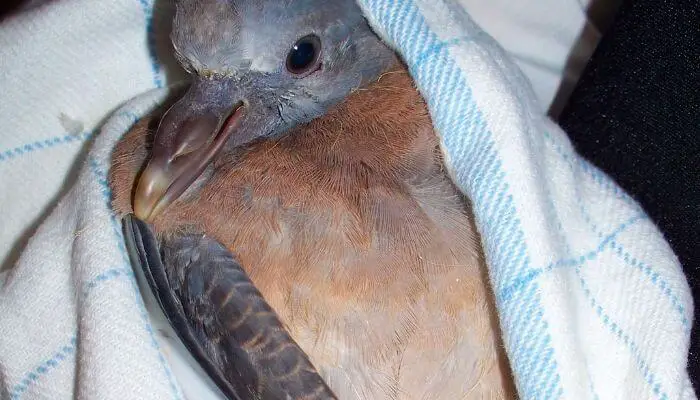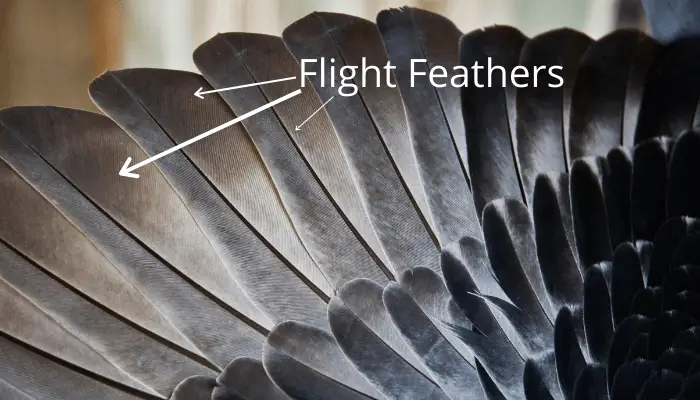The ethics of cutting a pigeon’s wings (or indeed the wings of any bird) are questionable, however if your pigeon has injured itself and is likely to get into trouble if it flies off then clipping its wing may be a reasonable course of action.
If you’ve never cut your pigeon’s wings before we strongly recommend you speak to your vet and ask them to do it the first time.
A vet will be able to show you exactly how to trim your pigeon’s wings without hurting them.
As an Amazon Associate I earn a small fee from qualifying purchases made through Amazon links. This helps us run the site – thanks for your support!
If you want to have a go at cutting your pigeon’s wings yourself then you will need:
- A towel
- Sharp scissors
- Someone to help (it is possible to do it on your own but it is safer and far easier with assistance)
Then follow these steps:
1. Secure The Pigeon
It is essential that the pigeon is restrained when their wings are being cut.
You will be using sharp scissors so if the pigeon starts to struggle during the cut accidents could occur.

If the pigeon is very comfortable with you and if you have someone helping you, then you may be able to hold the bird against your body with one hand (you’ll need the other hand to spread out the wing).
If you are cutting the wing without any assistance then you will need to wrap the pigeon in a towel or blanket.
Use the towel as a mitt to catch and hold the pigeon gently but firmly
Make sure that you are holding the pigeon with a loose grip, if you hold them too tight they will not like it and are likely to struggle and fight back.
2. Gently Spread Out The Wings
Move the towel down slightly on one sode of your pigeon’s body to allow a wing to poke out.
Slowly and gently extend the wing.
3. Identify The Correct Feathers To Cut
You should only clip the primary flight feathers when clipping your pigeon’s wings.

Your pigeon’s wings features two set of overlapping feathers. The smaller overlapping feather shouldn’t be cut.
The larger primary flight feathers (as shown in the image above) are the ones you should cut.
You will be trimming the first 5-7 flight feathers.
4. Start Trimming From The Wing Tip
Take the scissors and begin clipping the flight feathers.
Some people prefer to leave the wing tip untouched for aesthetic reasons and just cut the preceding flight feathers (as shown in the video). Others prefer to cut through the wing tip.
Leaving the wing tip untouched will help them maintain balance easily however providing you cut both wings evenly this shouldn’t be a problem.
You should clip the feathers carefully one feather at a time to avoid doing damage.
Each flight feather should be clipped down to about 1cm before the shorter overlapping feathers.
5. Be Careful Not To Harm Your Pigeon
Newly formed feathers, also known as blood feathers, will bleed if cut.
Take care to watch out for these and avoid cutting them.
You will be able to see blood running through the stem of the feather, if you see this avoid cutting into that part of the feather.
Warning:
If you accidentally cut a blood feather it will not stop bleeding on its own, this can result in death.
The feather will need to be plucked out completely with pliers. You should take your pigeon to the vet immediately to get this done safely.
If you notice that your pigeon has a lot of blood feathers then this suggests that they are too young to have their wings cut.
Wait a few more weeks for their feathers to mature before clipping.
6. Make Sure The Wings Match
When you’ve finished the first wing move over to the second wing.
You should trim the same feathers to the same length on both wings.
This will prevent them from becoming unbalanced when perching.

This article was written by our qualified veterinarian Cristina.
This is part of our commitment to providing you with the most trustworthy veterinary advice for your pigeons.
Sources:
